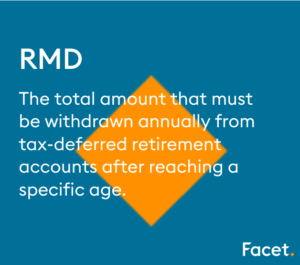
The information provided is based on the published date.
Key takeaways
- A required minimum distribution (RMD) is the amount a person must withdraw from their tax-deferred retirement accounts each year once they reach a certain age
- The amount of an RMD depends on the account holder’s age and total value of all retirement accounts
- Failure to take out an RMD can result in a 50% penalty on the amount that should have been withdrawn
- Beneficiaries who inherit IRAs may use different methods for calculating their mandatory distributions based on when the account owner passed away and what type of beneficiary identity they fit into
- Many beneficiaries have the option to split up their RMD over multiple distributions throughout the year and donate up to $100,000 to charity
What is a required minimum distribution (RMD)?
A required minimum distribution (RMD) is the total annual amount a person must withdraw from their tax-deferred retirement accounts once reaching a certain age. These mandatory distributions come out of employer-sponsored retirement plans, traditional IRAs, SEPs, or SIMPLE individual retirement accounts (IRAs).
What’s the point of required minimum distributions?
RMDs ensure that individuals don’t benefit from tax-deferred growth for too long—and can help prevent people from using their tax-deferred retirement accounts as an estate planning vehicle.
Plus, taking out the required amount helps to reduce taxes owed by having money distributed in the current year rather than deferring until a later time when it could be subject to higher tax rates.

How to calculate your RMD
Your required minimum distribution amount depends on two main factors: your age (life expectancy factor) and the total value of all of your retirement accounts.
To calculate your RMD, you must divide your previous year’s account balance by a distribution period based on your age.
The easiest way to get a rough estimate of your RMD is to use the IRS’ “Uniform Lifetime Table,” which accounts for your life expectancy based on various actuarial factors. Investor.gov also has a tool you can use to calculate your RMD.
Calculating RMDs: resources
- IRS Uniform Lifetime Table
- Investor.gov required minimum distribution calculator
RMD age requirements
Once you reach age 72 (or 73 if you turn 72 after December 31, 2022), it is commonly required you begin taking withdrawals from your IRA, SEP IRA, SIMPLE IRA, or retirement plan.
- Retirement account holders must begin withdrawals by April 1st of the year following their 73rd birthday (as of 2023).
- Taxpayers must calculate their RMD every year, even if they already withdrew the maximum amount allowed by the IRS in prior years.
Due to changes outlined in the SECURE Act, beginning in 2024, holders of designated Roth 401(k) accounts will no longer need to take RMDs. This rule already holds true for Roth IRAs.
What happens if I fail to take my RMD?
If you don’t take your required minimum distribution, you may be hit with a penalty up to 25% the amount that should have been withdrawn.
For example, if your required minimum distribution for the year is $20,000 and you fail to withdraw it, the IRS could impose a $5,000 penalty.
Although a CPA may be able to help you reduce this penalty, taking out the exact amount of your RMD each year is the best way to avoid any hefty penalties.
RMDs and inherited IRAs
An inherited IRA, also called a “beneficiary IRA,” happens when one or multiple designated beneficiaries receive a deceased person’s individual retirement account.
The RMD treatment for beneficiaries is based on the multiplier the original account owner used during the year they passed away.
In addition, beneficiary RMD rules vary based on “identity” during the years after the account owner’s death.
These identities include the following:
- surviving spouse
- minor child
- disabled individual
★ Attention spouses: If you are the sole beneficiary of your spouse’s IRA, you can take the reins of the account through a spousal transfer. The IRS will consider the IRA like it was yours from the start, allowing you to make additional contributions. Unlike other transfer options, RMDs will be based on your life expectancy, not the deceased's.
If you inherit an IRA from someone who passed before January 1, 2020, you calculate your RMD using the IRS Single Life Table.
If the account owner passed away after December 31, 2019, you must follow the RMD rules outlined in the SECURE Act.
These rules differentiate between eligible, designated, and non-designated beneficiaries. So, the timeframe and calculation of your RMD can vary based on your designation.
For instance, some beneficiaries may have to withdraw the entire account by the 10th calendar year following the IRA owner’s death after 2019.
In contrast, some non-designated beneficiaries may have to distribute the entire account within five years of the IRA owner’s death.
(These regulations void the use of a stretch IRA, a strategy some inherited IRA recipients previously used to prolong tax-deferral of IRAs.)
Is there anything else I should know about RMDs?
It’s important to understand that you don’t have to take your whole RMD simultaneously. You can split it up over several different distributions throughout the year.
You also have the option to donate up to $100,000 of your RMD to a qualified charity. A Qualified Charitable Donation (QCD) can potentially help lower your taxable income.
Finally, keep in mind that if you have multiple retirement accounts, you will need to calculate an RMD for each account. This will help you better plan your retirement distributions and avoid penalties by ensuring you don’t miss any RMDs.
Final word
Understanding the RMD rules and regulations is essential for retirees who wish to make the most of their retirement accounts. You must calculate your RMD accurately and withdraw the required minimum each year. If you fail to do so, you will be subject to hefty penalties.
For those who inherit an IRA, it’s essential to understand the new rules and calculate your RMD based on the decedent’s age at the time of their death and your identity in the years that follow.
Of course, it’s always a good idea to consult a financial planner for advice on the best course of action. They can help you navigate the rules and ensure you make the right decision every tax season.
Additional resources:
Facet
Facet Wealth, Inc. (“Facet”) is an SEC registered investment adviser headquartered in Baltimore, Maryland. This is not an offer to sell securities or the solicitation of an offer to purchase securities. This is not investment, financial, legal, or tax advice. Past performance is not a guarantee of future performance.


